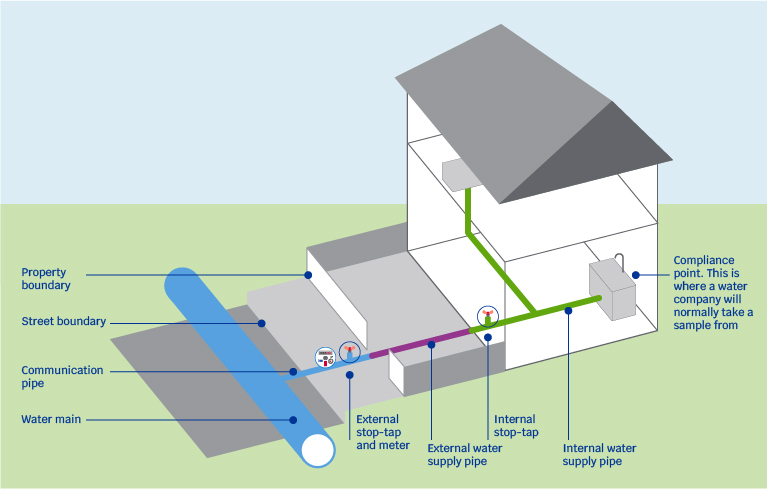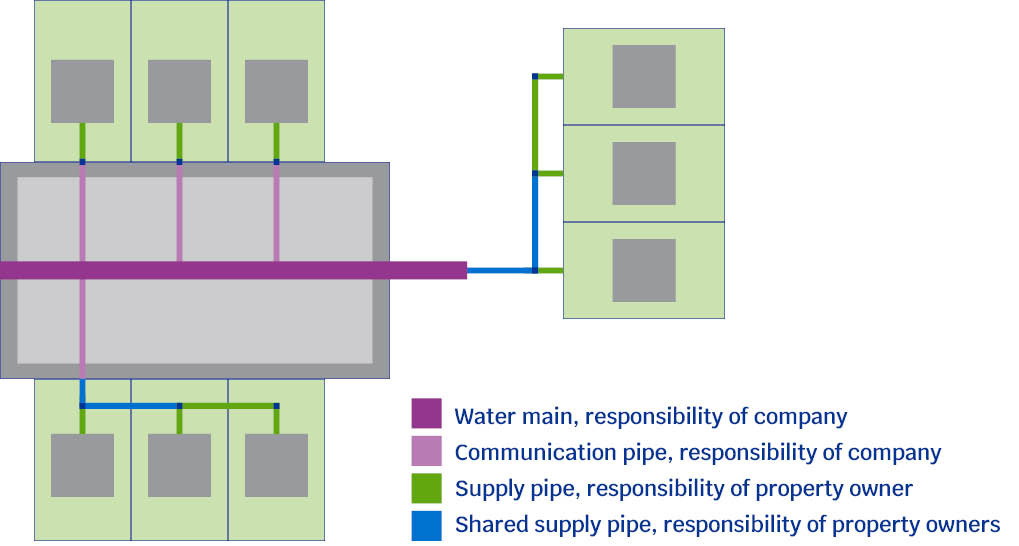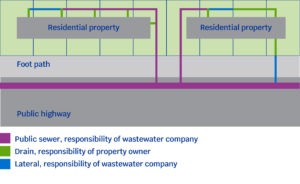Water pipes
Responsibility for the pipework that supplies clean water is shared between property owners and water companies.
There are three different types of water pipes.
- Water mains are the large company pipes that distribute water around the network. They are often, but not always, laid under highways.
- Communication pipes carry water between the water mains and the boundary of private property. If a company stop-tap has been fitted, this will normally mark the end of pipework that is the responsibility of the company and pipework that is the responsibility of the property owner. Not all properties will have their own stop-tap in the footpath but where one has been fitted, this is normally the responsibility of the company to maintain.
- Supply pipes are the smaller pipes that carry water from company pipework into the property. Supply pipes run from the boundary of the property (where there may be a company stop-tap) up until the first water fitting or stop-tap inside the property. Stop-taps along the length of the supply pipe, and any water fittings, are the property owner’s responsibility to maintain.
Usually, responsibility for different types of water pipes is as shown in the table and diagram below. However, there may be special cases in some areas, and you should contact your water company, and consult the deeds to your property to find out more.
| Type of pipe | Laid under | Responsibility for pipe |
|---|---|---|
| Water mains | Highway | Water company |
| Property owner’s land | ||
| Land owned by someone else | ||
| Communication pipe | Highway | Water company |
| Supply pipe serving a single property | Highway | Property owner |
| Property owner’s land | ||
| Land owned by someone else | ||
| Shared supply pipe serving more than one property | Highway | Joint responsibility of all property owners served by pipe |
| Land owned by any of the property owners served by the pipe | ||
| Land owned by someone else |
Supply pipe repairs
You are responsible for the drains, water pipes and plumbing fixtures on your property. You are also responsible for ensuring that the plumbing in your property conforms to the required standards. We are not responsible for regulating plumbing.
You must maintain the supply pipes that are your responsibility. This includes leak detection, repairs and replacement. You should contact your water company to find out if they offer help for subsidised or free repairs.
Each company must have a code of practice which sets out how they address any leakage from household supply pipes.
If you have a water meter and your bill was abnormally high because of leakage that has since been repaired, you may be able to claim an allowance for the cost of water lost. You should contact your water company for more information. Companies have specific responsibilities to check supply pipes for leakage when meters are fitted and to carry out repairs where no further excavation is required to do this work.
If your company has recorded leakage in your area but cannot source the leak to their pipes, they may issue a legal notice under the Water Industry Act 1991 to inform you of a potential private leak and your legal requirement to fix it. This notice will advise you of timescales. If you do not fix the problems in the time allowed, the company can carry out the works and pass on the costs to you.
Water companies are responsible for the maintenance of communication pipes and mains which includes leak detection, repairs and replacement where necessary. If the company carries out work on pipework for which they are responsible, including laying new mains, they must follow a code of practice, which is available from the company.
Sewers and drains
Responsibility for sewers and drains is shared between property owners, water and sewerage companies, local authorities and the Highways Agency.
Sewerage companies’ responsibilities
Sewerage companies are responsible for the public sewers. These are usually in roads or public open spaces, but may run through private gardens. The sewerage company has a right of access to these sewers for maintenance. If the company carries out work on sewers on your land they must follow a code of practice, which is available from the company.
Property owner’s responsibilities
The drains and any private sewers which carry household waste are normally the householder’s (or the landlord’s) responsibility. This applies up to the point they connect with the public sewers. Since 1 October 2011 (following the transfer of private sewers), this is usually at the boundary of the property. The diagram below shows an example of the responsibilities of householders and sewerage companies.
Local authorities’ responsibilities
Local authorities function as landlords for council houses and are responsible for highways drainage, including gullies, on the roads they maintain.
Highways Agency’s responsibilities
In England, the Highways Agency is responsible for highways drainage on the trunk roads and motorways they maintain.
Pumping stations
Pumping stations help pump your wastewater to the local sewage treatment works. You may have one in your back garden or on land next to your home. They vary in size – from manholes to large sheds.
From October 2016, private pumping stations that serve more than one property will become owned (‘adopted’) by the local sewerage company. This means the company will be responsible for paying for the station’s running costs or if it breaks down


